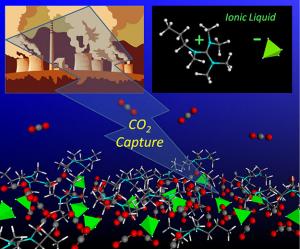
New method to cleaner and more efficient carbon dioxide capture
Jul 25, 2009 - ScienceDaily
 |
| Molecular modeling of CO2 capture by an ionic liquid membrane. A typical fossil-fuel plant (top left) produces significant CO2 and other greenhouse gas emissions. A membrane based on ionic liquids may absorb such emissions. (Credit: Image courtesy of DOE/Lawrence Livermore National Laboratory) |
ScienceDaily (July 25, 2009) — Separating carbon dioxide from its polluting source, such as the flue gas from a coal-fired power plant, may soon become cleaner and more efficient.
A Lawrence Livermore National Laboratory researcher has developed a screening method that would use ionic liquids — a special type of molten salt that becomes liquid under the boiling point of water (100 degrees Celsius) — to separate carbon dioxide from its source, making it a cleaner, more viable and stable method than what is currently available.
There are major efforts to reduce CO2 emissions from burning fossil fuel, but before it can be sequestered, it must first be separated from its source, a step known as "capture." This new technique could significantly enhance the efficiency of the CO2 capture process.
Currently, the few coal plants with commercial CO2 capture capability all use processes based on chemical absorption with monoethanolamine (MEA), a general-purpose solvent developed by chemists some 75 years ago. Unfortunately, it is non-selective, corrosive, requires the use of large equipment, and effective only under low to moderate partial pressures of CO2.
But the new system overcomes many of these shortcomings. Chemists recently became interested in ionic liquids because they are solvents with almost no vapor pressure, and do not evaporate, even under high temperature conditions.
Using ionic liquids as a separation solvent has unique advantages over traditional solvents, according to LLNL scientist Amitesh Maiti, whose research appears as the cover article in a recent issue of ChemSusChem, a new journal focused on chemistry and sustainability.
Advantages include high chemical stability; low corrosion; almost zero vapor pressure; supportable on membranes; and a huge library of ion choices, which can be potentially optimized for CO2 solubility.
Maiti's work involved devising a computational strategy that can reliably screen any solvent, including an ionic liquid, for high CO2 capture efficiency.
"It's a great advantage to have a method that can quickly and accurately compute CO2 solubility in any solvent, especially under the range of pressures and temperatures as would be found in a coal-fired power plant," Maiti said. "With ionic liquids serving as the solvent, the process could be a lot cleaner and more accessible than what is used today."
Over the last few years several ionic liquids have been experimentally tested to be efficient solvents for CO2, providing data that could be useful in optimizing the choice of ionic liquids for CO2 capture.
"But each new experiment costs time and money and is often hindered because a specific ionic liquid may not be readily available," Maiti said. "By creating a computational tool that can decipher ahead of time which ionic liquids work best to separate CO2, it can be a much more efficient process when field tests are conducted."
Maiti developed a quantum-chemistry-based thermodynamic approach to compute the chemical potential of a solute (CO2 in this case) in any solvent at an arbitrary dilution. He found that this result coupled with an experimentally fitted equation-of-state data for CO2 can yield accurate solubility values in a large number of solvents, including ionic liquids. He confirmed this by directly comparing the computed solubility with experimental values that have been gradually accumulating over the last few years.
Next, he used this method to predict new solvent classes that would possess CO2 solubility nearly two times as high as the most efficient solvents experimentally demonstrated.
"With the vast choices of ions, we have barely scratched the surface of possibilities," Maiti added.
His hope is that the accuracy of the computational method will allow scientists to see useful trends, which could potentially lead to the discovery of practical solvents with significantly higher CO2 capture efficiency.

|